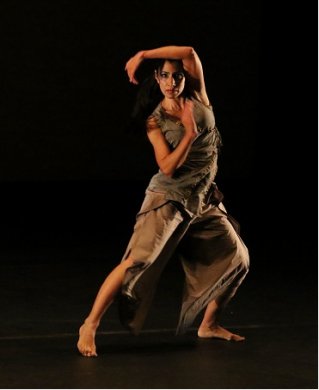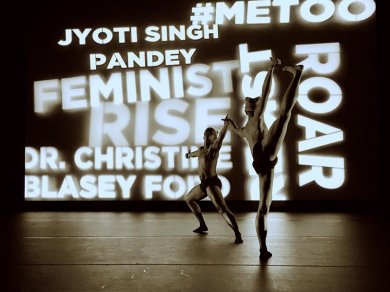
|   |

|   |
Redefining dance forms - Dora Ruzic November 6, 2018 The performance of Reimagining Indian Dance: Moving Forward was presented at the Asia Society Museum and was co-curated by Rachel Cooper and Rajika Puri. The program consisted of six different performances of different styles and interpretations of Indian dances. First, the "Cosmic Dance of Siva" (1926) was presented - a black and white movie of Ted Shawn, the father of modern dance, who danced, what we today would perceive as a classical interpretation of a Shiva dance. This set the mood of the evening to be one of a serious and devotional portrayal of Indian classical dance. However, immediately after the film sequence, Phil Storm comes on stage and shatters our preconceived ideas. He steps on stage dressed in classical Indian attire; we expect the same effect of the movie. Yet, Storm proclaims "F*ck this!" takes the robe off and shows off his fishnet costume in an acrobatic, fast-paced dance performance called "Mea Culpa". The 'sin' of the Culpa probably speaking more towards our ideas of tradition than towards his apologetics of performance. 
Parul Shah
(Photo by Ellen Wallap, Courtesy: The Asia Society) The second performance called "Enduring Silence" was performed by Parul Shah. It was a solo dance accompanied with a violin, cello and tabla. Shah started by following the music and slowly throughout the sequence, the music started to follow her. Shah was raised in the Kathak dance tradition; however, like Storm in his performance, she takes the ideas and lessons of the tradition and pushes off them, as if from a jumping board, forward in new directions. Her performance had moments of Kathak, especially in her feet movement and stomping. However, her body language and her fluidity moved as if watching a western modern dance performance. She portrayed the idea of "enduring silence" by fighting to break out of it, being slow and easy at times, being a part of it, while also attempting to step out of it, with strong and firm feet stomps, with her arms folding as if tied with cuffs, but bending to break away from them in a fast-paced dance interpretation. Next, Kuldeep Singh performed his choreography of "Re-thinking Orissan Dance" that was accompanied by two singers and two musicians. Singh wore a full Orissan costume, holding on to the tradition. Yet, in his movement, he stepped away from it at times. However, to me, it seemed that the 're-thinking' of the dance form in his performance, did not go nearly as far from tradition as the other dances and performances did. Second to last was Sheetal Gandhi's one-woman show of dancing, singing and acting called "Bahu-Beti-Biwi". Gandhi, with her multi-talents took the stage and the audience with her from the first moment. She began her sequence with her face covered with a veil, sitting on the floor. The voice-over went with her movement, while she portrayed the traditional way of learning Indian dance, by repeating word 1, then again word 1 then word 2. She portrayed the words in traditional hand movements to follow the story; however, her text spoke of her wish to throw powder at her father's face, so she can free herself. Her performance continues in the idea of women and their fight for freedom. She plays out a scene of falling in love and yet marrying the other man that her parents want. Following, she plays the mother that now criticizes her daughter for not letting her choose her husband, following the same 'problems' that her parents did to her. Gandhi, however, does all of this through a comedic monologue that therefore makes the topic even more important. 
Holy Cow(s) (Photo:
Shana Hillman)
The last piece of the night was Holy Cow(s)! directed by Hari Krishnan, the same artist that choreographed the opening piece of Mea Culpa. Here, just like with the beginning piece, we are back to a 'more' outrageous way of redefining the dance forms in their connection towards the society today. Krishnan's choreography had two parts. First, Paul Charbonneau performed a solo, a strong man in a little black tutu danced a choreography that seemed to question and push the ideas of women and society. Charbonneau, through jumps from left to right and his straight-palm movements used the traditions of Bharatanatyam at times, however, in a fast-paced and less technical way, thus making it a modern interpretation of a current social thematic. The second part of Krishnan's choreography was a duet danced by Roney Lewis and Xi Yi that even more directly spoke about (or screamed about) the oppression towards women, specifically in America today. Lewis and Yi started with in sync mirrored motions, presenting women in society today. However, on the black panel behind them the projected words showed up of #METOO, ROAR, DR. FORD etc. Then, Lewis and Yi's duet stopped being a mirrored image of one another and turned into one portraying a woman and another, a man (or society) that is trying to overpower her. One of the moments of this was portrayed with Yi lowering himself to the ground and Lewis standing tall behind him and pulling his arms. The ending of Krishnan's Holy Cow(s)! was with all his dancers coming out with shirts of support for the #METOO movement and a clear protesting political message towards the US government today. The Holy Cow(s)! thus united the idea of Indian dance tradition through the 'Holy Cow' that we saw in the movement that drew from Bharatanatyam tradition. However, the modern aspect was the connection to the social injustices today and a protest of today towards the land of 'Holy Cows!' as in an emphasized surprise sentence of 'how can this be happening?' Overall, the night of re-imagining Indian dances, truly did justice to its title. From Siva and Kathak to Bharatanatyam, the show portrayed both the tradition of where these dances are rooted, while also, it gave us a strong sense of where the dance is today and where it can go. Dora Ruzic is a performing artist. She has graduated from a performing arts conservatory in NYC and is currently pursuing an academic oriented degree at Columbia regarding the performing and visual arts. This review was written in partial completion of Uttara Coorlawala's course at Barnard College/Columbia University in South Asian dance history. |